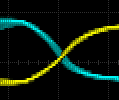What is Slew Rate Limiting and when should I use it?
Slew rate is a measurement of how fast the signal voltage changes over a specified period of time. At high data rates, you need a fast slew rate to ensure that the data is received accurately. At low data rates, an unnecessarily fast slew rate can introduce EMI (electro-magnetic interference) on the signal lines.
Slew Rate Limiting is a software-selectable feature found on Sealevel ultra high-speed serial adapters including the 7205ec and the 7106e.
These asynchronous serial adapters have the ability to operate at very high data rates exceeding 1 Mbps. When you are transmitting data at data rates lower than 250 K bps, enabling slew rate limiting in the Windows driver will slow down the signal voltage transition, also referred to as edge-time, and reduce the chances of EMI in your application.
The oscilloscope trace in the first image shows a serial signal with slew rate limiting disabled and the second image shows the same serial signal with slew rate limiting enabled.

Figure 2. Slew rate limiting ENABLED
